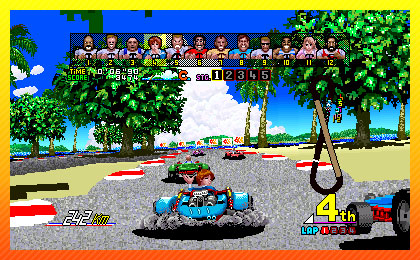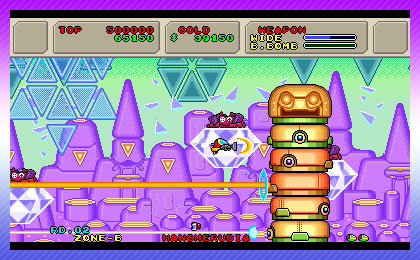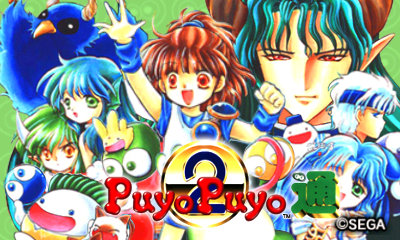
RS Reviews are back, this time looking at the special compilation pack SEGA 3D Classics Collection for the Nintendo 3DS. Not only this will be a newcomer review but also one with a special twist!
Everyone (mostly everyone, anyway) remember fondly on those games you used to play when you were younger but now you no longer have them. That, and certain childhood favorites can carry a steep price these days. Well, if you’re a SEGA fan who’s been dying to play a collection of some the finest titles in their prime all in one convenient package, no look further than the “SEGA 3D Classics Collection.”
The SEGA 3D Classics Collection is a nine-game compilation of SEGA titles, with a majority of them originally seeing an arcade release first. Done by the awesome studio M2, these titles aren’t just straight emulated ports. M2 went all the way the source code for these games and essentially rebuilt them from the ground up to include special features while still maintaining their original quality. The Western (so far only North America received it, but here’s hoping European fans can get in on the action) version of this title is actually the sequel compilation to the original in Japan, which was called “SEGA 3D Fukkoko Archives.” Nevertheless, out of the nine games featured here, four of them never seen a proper standalone release on the Nintendo eShop. Two from those four being 3D Power Drift and 3D Puyo Puyo 2; the other two titles are ‘bonus’ games exclusive to the collection, “3D Maze Walker” and “3D Fantasy Zone II: The Tears of Opa-Opa.”
How this review is going to go may be a tad different from others. I figured it going over games that already received their standalone releases may be a tad repetitive. So what this review will do instead is go over the titles new to this side of the world as far as this collection is concerned. That means I’ll be reviewing 3D Power Drift, 3D Puyo Puyo 2, 3D Fantasy Zone 2 W and its Master System predescor 3D Fantasy Zone 2: The Tears of Opa Opa and finally 3D Maze Walker. Secondly, all these games will be reviewed by a newcomer (that’s me!) who has never played these games in their original formats, so you’ll get the freshest viewpoint possible. That’s right; Not only that, I’ll be talking about the four games I have never played myself until now. I will also be using a similar review format to previous reviews for better consistency. To finish, I will go over the pros and cons of the game as a whole as well as point out any special features. So without further ado let’s tackle the first of these games: 3D Power Drift!

3D Power Drift
Out of all the titles in this collection, 3D Power Drift was arguably the one I wanted to get my hands on first. Having found 3D Super Hang On and 3D OutRun two of my more favorable outings from the 3D Classics line I was sure it could hold up alongside those two. With certainly I can definitely say that it did. For a brief explanation of the game, it was originally developed by the legendary SEGA AM2 for arcades in 1988. Using super-scaler technology of heavy sprite-scaling and rotation it gave drivers the illusion of 3D while still using 2D assets.
Visuals:
Speaking of that, let’s get down to the biggest change to this version of the game: the 3D effects. Now I have a Nintendo 3DS XL so my 3D isn’t as ‘super-stable’ as the N3DS models are. With that said, what 3D Power Drift can really do is make your races pop out and make you really immersed in your driving. The super-scaler technology is impressive in its own right at the time, but with the new 3D effect it brings a whole new depth to the gameplay. With that said, sometimes the effect is a bit too much on the eyes, seeing as it’s a more frantic and more attentive game but for what it’s worth it does the job. Even then with or without the 3D effect, 3D Power Drift is still a visually appealing game, with its locales/tracks down to the characters expressiveness themselves. Alongside the 3D (and similar to other 3D SEGA Arcade titles) you have the option of changing the display as well as keeping the HUD static of having it move while playing.
Gameplay/Controls:
Similar to Super Hang On your goal is to finish a predetermined number of laps while placing in

the top three positions. As the name of the game implies, to perform skillfully you’ll need to master your Gear type to drift your way to victory. There are two specific Control Settings, as well as having the option of changing the button layout. There’s also four Gear types: Switch, Toggle, Hold and AP. You need to learn these Gears and how to properly use them to make those corners and get the one-up on your rivals. From playing it did take some time for me to properly control my character and understand the feature. I have

more of a preference for Switch and Hold as I fared much better with those and got higher scores that way. In all, using the Circle Pad for movement feels so much more tighter as it gives you much better control when making those corners. At first, even trying to reach 4th was a hassle due to how accustomed I was to the default control scheme and using memory work the first couple times playing! Nevertheless, once I found my groove things became a lot smoother. In general, the controls feel responsive, shifting gears became a matter of knowing when to do so and drifting became so nice to pull off once you got the hang of it.
Sound:
M2 spared no expense giving these titles a new breath of fresh air while remaining loyal to their original sounds. 3D Power Drift is no exception. From the tracks played during gameplay, the sounds of your vehicle speeding on paved road, dirt, grass and the like, every sound is clearly defined while all coming together to give you an enjoyable experience. Don’t want to hear all that background noise apart from the in-game music? Well M2-enabled features include an option to turn on or off the environmental SFX at your leisure and even Equalizer control.

3D Fantasy Zone 2 W
*For the purpose of this particular game I will also include its SMS version
Visuals:

I’ll just get this out of the way now; 3D Fantasy Zone 2 W (and its Master System counterpart) are by far the most visually appealing games out of the whole collection. The vibrant colors, surreal environments and colorful presentation is a blessing on the eyes. The 3D effects enhance the already solid presentation with some great pop-out effects. As this game isn’t as intensive with its action in-game compared to say, 3D Power Drift, I had much easier time playing in the 3rd dimension for the most part. I’m more of a sucker for a bit of surrealism in my games from time to time, and 3DFZ2W fills that niche nicely.
Gameplay/Controls:
Akin to other horizontal scrolling shoot ‘em ups you control the sentient spaceship Opa-Opa as you shoot and bomb your way through an infinitely repeating loop through a series of stages. In 3DFZ2W you can play in either Story Mode or Endless Mode; in FZ2 you can play with the in-game Radar On or Off and a Helper Mode for novice players. Once your goal in each stage is met by destroying ‘Bases’ you will encounter that level’s boss. Now how 3DFZ2W and Tears of Opa Opa play within that basic premise is different. In 3DFZ2W each stage has two versions of itself that act on parallel planes, a Dark and Bright Side. The former is more difficult than the latter, but bases destroyed in one will also be destroyed in the other, making it less of a chore to complete the stage outright. Not to mention clearing more obstacles in Dark Side nets you more rewards. In the original SMS version, each level has three Zones that inhabit it that are uncovered when certain Bases are destroyed, revealing Warps. The end goal is to clear all the Zones and the Bases that occupy them before you can face that level’s boss.

Both games control very similarly tpp, which makes sense considering for the most part FZ2W has been considered more of a ‘What If’ remake on System 16 hardware of the SMS original. Shooting feels precise and react well to enemies, and your input determines the rate of fire. Repeated taps of the button will produce rapid fire shots, holding down the button will start off with a second delay of a couple shots before continuous fire occurs but stops as soon as you release the button. Dropping bombs works in the same way. Opa’s movement is also well controlled as I had no issue maneuvering through the levels, although I did take time to appreciate the backgrounds more on my initial playthrough of the game. There are times when opposition comes flying in and it leaves you in a frantic pace of shooting them down and maneuvering yourself but that comes with being skillful of when to use bombs from above or shooting your way through.
Sound:
Composer Manabu Maniki did a good job giving each of the levels a concise beat and flow with their accompanying track. It doesn’t take away from the gameplay while complimenting the levels themselves. Seeing how this is my first ever time playing these two games I never released W2’s soundtrack were arrangements of the original FZ2 melodies done by Tokuhiko Uwabo until I played both one after the other. Having heard the first Fantasy Zone’s music once before this soundtrack definitely provides a more mellower take on the some of the first game’s sound. In that way it provides a unique cross in of itself; trying to be more distinct on its own but still employing certain musical cues fans of the original will pick up on through repeated playthroughs.

3D Puyo Puyo 2 (3D Puyo Puyo Tsu in Japan.)
Visuals:


Not being much of a puzzle person but reallyappreciating the later games in the series’ artstyle and aesthetics I can say I appreciate the early Compile era of Puyo Puyo. It has a distinctive chibi-like atmosphere that works for the early games. The characters’ designs are charming and add to the cuteness factor during gameplay. They’re also pretty expressive (when chaining combos, when your board is near filled to the brim with Garbage Puyos) and helps keeps the game look fresh and in motion as you scramble to clear your board and achieve those scores. I find it strangely adorable when your rival start sweatingng nervous when their board is half-way filled with regular and Garbage Puyos, hahaha. Other than that, it being a puzzle game means you’re not going to get much in-your-face visual motion but for what it is it’s still a visually decent game.
Gameplay/Control:


Like its predecessor you have to clear a board by matching specific colored Puyo to achieve a combo to add to your score while also making sure yours doesn’t get cluttered from via the opponent and vice versa. It’s much more in-depth however as not only you need to know where you’re properly placing your beloved Puyo to rack up big combos, but to counter incoming attacks from the aforementioned Garbage Puyo with your own by successfully pulling off your combos. This is a new feature called ‘Sousai (Garbage Countering)’. The more well versed you are at this technique, the more Garbage Puyo your opponent will end up with, otherwise known as ‘Garbage Overflow’. The key to being successful in this game is to know how to pull of these off on higher difficulties as the rivals’ AI will instill strategies that will surely trip you up if you’re not careful.
Ok down to the nitty gritty, how the game controls. Again, having never played the original I can’t say for sure how controls feel over it. What I can say is that controlling your Puyo to where you want them to go is solid enough. I have played other similar puzzle games of this type (cough cough Mean Bean Machine cough) so nothing too major in its control scheme is to be written off about. You do have the option of inverting the direction you want to turn the Puyo in the settings, if you so fancy. Things can get hectic though and you’ll likely to briefly panic when half your board is suddenly filled with Garbage Puyo you’re desperately trying to clear them away. Best to keeping an open mind and planning out your moves. 3D Puyo Puyo 2 also supports Local Play, and it is much more fun playing with someone else who knows what they’re doing. You can also play with alternative rules and an ‘Offset Mode’ which does change up parts of the game you’re playing.
Sound:
As crisp as the other 3DS Classics, with a quirky often humming-along beat while playing. Despite the premise of the game’s single player mode (Satan himself creates a tower in order to steal the protagonist Arle’s heart as well as another’s character named Kaa-Kun and so our heroine must battle her way up the tower by defeating a certain number of matches before advancing upward) the music is still as charmingly enjoyable. It’s feel-good music that the casual crowd and easily sink into and doesn't detract from the core gameplay at all. In fact it enhances it through and through.

3D Maze Walker
Visuals:
This game is just as visually appealing as the other titles in this collection, and that is a definite plus in my book. The added benefit of it being seen in 3D was touted as one of the game’s big features via the SegaScope 3D peripheral back in the late 1980s. While I don’t have that to see it for it myself...that’s what the 3DS is for. I will say that...it didn’t impress me as much. In fact I’ll go out on a limb and say the 3D effect for Maze Walker may have have the weakest experience out of not just the four games I’m reviewed but out of the whole collection. It doesn’t really pop out as well as I thought it would. Sometimes I felt disorientated by how the environment was displayed when the effect turned on. The colors and shading of certain levels didn’t look real disingenuous from each other in 3D, which didn’t impress me. Ergo, I couldn’t see much of the depth I was hoping to experience. Personally, I would recommend playing this one with the 3D effect off for the most part as you’re not missing much.
Gameplay/Control:
The premise of this game is relatively simple; your player character must make their way out of a series of different mazes from a top-down perspective, all the while having a lone stick as your only means of offensive and defense against a bevy of monsters. What this game touts is the sense of depth you have when playing with the SegaScope 3D Glasses. Again, relatively simple.
I would say I had the weakest overall enjoyment out of the collection of games here. How your character controls just feel a bit too slow for my liking and the pace doesn’t feel as enticing as I felt it can be at times. Jumping is a blessing here as I can make much more leeway than simply walking about. In fact, jumping WILL be your best friend here as without I feel this game would even be more of a chore. That and your trusty stick.
Speaking of which, getting hit with it makes you lose it and it gets randomly generated someplace in the level. Simply find and pick it up to use it again. Obviously taking damage without the item and you’ll lose a life. In order to progress to the next area of the level you’ll need to pick up certain objects that will unlock pads. Stepping on these pads will teleport you closer to the center of the level, which is also the exit. You can play without the stick, but the closer you get to the exit the most enemies will be grouped closer to it to be weary of that. I was just jumping over most of the enemies or failing that maneuvering myself around them since the AI is programmed on a four-directional arc while you have eight thanks to the circle pad. Even so, I feel the combat at times takes away from your main goal of reaching the center since that’s what you’ll primarily be focused on, which is finding the fastest way to get out of there. Combat is honestly secondary when it comes down to it unless you are really that ‘clear everything out first’ type of player.
Sound:
The Master System is a wonderful console, being able to produce surprisingly quality sound and even more than 25 years later it sounds as crisp as it did back then. There’s a more ambient sound for Maze Runner which I can appreciate for certain games that doesn’t instill a bombastic experience or tone. Sound effects are also pristine; the jump effect is going to be or will be your most common sound due to how much you will likely need to use it to clear levels though.
~~~~~
I already mentioned that when it comes to these games and their original release dates in this collection itself I am technically a newcomer. All the titles here I have never played in the original forms and timeframe and as someone who came into being a SEGA fan post Dreamcast, I have no say in feeling a childhood attachment to them. Sitting down and playing through these games in their rebuilt state afftirms though the intent of what these collection represents; these aren’t some run-of-the mill collection of retro games though. Each one had care put into them to make sure you’re getting that authentic experience with the added benefit of being on the go.
Since the West never received the first compilation of titles it’s unconfirmed if 3D Fantasy Zone can be unlocked if data for that is found on the 3DS system itself. Regardless it’s still 9 games in total for its retail price of $30 USD. On the other hand, other than hardcore SEGA enthusiasts it may not be what the casual crowd may be into, especially seeing that half the titles in the Collection can be brought as standalone entries on the eShop. Even then, if you’re looking to save cash on those titles than this is a good deal if you’re able to spend.
Ultimately, if you’re a budding SEGA fan who missed out on their golden years and have a desire to see what you missed, I implore you to pick this up. There’s a wealth of solid games, excellent music and timeless presentation M2 went into with this. You even get helpful tips from Professor Asobin during games' boot ups! For older fans, it’s a testament to the genius the Blue Brand had at the time in that these games can still be wholly enjoyed today. The 3D Classics Collection is not just a love letter to SEGA fans old and new but a nice collection in its own right.
Features:
Pros:
Cons:
Requests between 15th Apr and 21st Apr